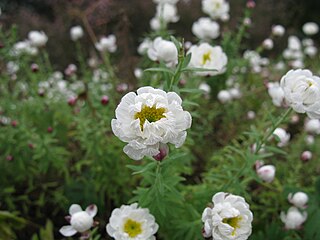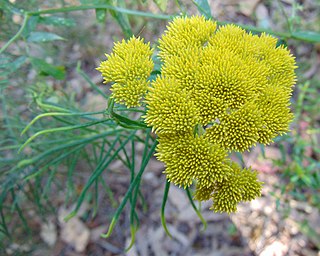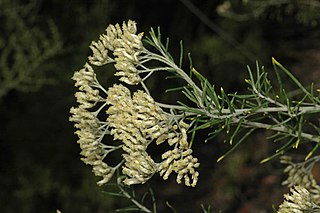
Xerochrysum bracteatum, commonly known as the golden everlasting or strawflower, is a flowering plant in the family Asteraceae native to Australia. Described by Étienne Pierre Ventenat in 1803, it was known as Helichrysum bracteatum for many years before being transferred to a new genus Xerochrysum in 1990. It is an annual up to 1 m (3.3 ft) tall with green or grey leafy foliage. Golden yellow or white flower heads are produced from spring to autumn; their distinctive feature is the papery bracts that resemble petals. The species is widespread, growing in a variety of habitats across the country, from rainforest margins to deserts and subalpine areas. The golden everlasting serves as food for various larvae of lepidopterans, and adult butterflies, hoverflies, native bees, small beetles, and grasshoppers visit the flower heads.

Cassinia denticulata, commonly known as stiff cassinia, is a species of flowering plant in the family Asteraceae and is endemic to eastern New South Wales. It is a shrub with yellowish stems, finely-toothed, egg-shaped to elliptic leaves, and heads of pale yellow flowers arranged in a dense corymb.

Rhodanthe anthemoides, commonly known as chamomile sunray, is a flowering plant in the family Asteraceae. It is a small, perennial shrub with greyish-green leaves, white papery flowers, yellow centre and is endemic to Australia.

Cassinia arcuata, commonly known as drooping cassinia, biddy bush, Chinese scrub, sifton bush and Chinese shrub, is a species of flowering plant in the family Asteraceae and is endemic to Australia. It is a shrub, sometimes a small tree with sessile, linear leaves, and heads of up to two hundred brownish flowers arranged in pyramid-shaped panicles. In New South Wales, the species is known as Cassinia sifton. In disturbed areas, C. arcuata can become weedy.

Cassinia laevis, commonly known as cough bush, dead finish, curry bush or rosemary bush, is a species of flowering plant in the family Asteraceae and is endemic to south-eastern continental Australia. It is a shrub with a curry-like odour, crowded linear leaves, and heads of creamy-white flowers arranged in panicles.

Cassinia leptocephala is a species of flowering plant in the family Asteraceae and is endemic to New South Wales. It is a large, woody shrub with hairy, reddish stems, stiff linear leaves, and heads of pale yellow flowers arranged in a dense corymb.

Cassinia uncata, commonly known as sticky cassinia, is a species of flowering plant in the family Asteraceae and is native to inland New South Wales and the south-east of South Australia. It is an erect shrub with hairy young stems, narrow linear to needle-shaped leaves, and heads of off-white to cream-coloured flowers arranged in rounded, almost conical panicles.

Cassinia subtropica, commonly known as bushy rosemary, is a species of flowering plant in the family Asteraceae and is endemic to north-eastern Australia. It is shrub with woolly-hairy stems, lance-shaped to egg-shaped leaves and panicles of flower heads.

Cassinia longifolia, commonly known as shiny cassinia, is a species of flowering plant in the family Asteraceae and is endemic to eastern Australia. It is an erect, aromatic shrub with sticky, hairy foliage, linear or oblong to narrow lance-shaped leaves, and heads of creamy-white flowers arranged in a dense corymb.
Cassinia copensis is a species of flowering plant in the family Asteraceae and is endemic to eastern Australia. It is an erect, multi-stemmed shrub with aromatic, cylindrical leaves, and heads of creamy-white flowers arranged in a flattened corymb.

Cassinia decipiens is a species of flowering plant in the family Asteraceae and is endemic central New South Wales, Australia. It is a shrub with woolly-hairy young twigs, spreading, cylindrical leaves, and heads of creamy-brown to yellowish flowers arranged in a rounded cyme.
Cassinia furtiva is a species of flowering plant in the family Asteraceae and is endemic to a restricted area of New South Wales. It is a shrub with hairy, sticky stems, narrow linear leaves and 100 to 150 flower heads arranged in a rounded dichasium.
Cassinia ochracea is a species of flowering plant in the family Asteraceae and is endemic to south-eastern New South Wales. It is an erect or spreading shrub with hairy stems, needle-shaped leaves and flat or rounded corymbs of up to four hundred flower heads.
Cassinia straminea is a species of flowering plant in the family Asteraceae and is endemic to eastern Australia. It is an erect shrub with hairy young stems, linear leaves and corymbs of up to several hundred flower heads.
Cassinia theresae is a species of flowering plant in the family Asteraceae and is endemic to central New South Wales. It is an erect shrub with hairy young stems, needle-shaped leaves with flared bases, and corymbs of up to fifty flower heads.

Cassinia lepschii is a species of flowering plant in the family Asteraceae and is endemic to eastern Australia. It is an erect or spreading shrub with densely hairy young stems, needle-shaped leaves and flower heads arranged in flat or rounded corymbs.
Cassinia heleniae is a species of flowering plant in the family Asteraceae and is endemic to a small area in northern New South Wales. It is a shrub with a few sticky stems, sticky needle-shaped leaves and flower heads arranged in a rounded to flat-topped cyme.

Cassinia thinicola commonly known as sand everlasting, is a species of flowering plant in the family Asteraceae and is endemic to coastal New South Wales. It is a compact shrub with hairy young stems, needle-shaped to slightly flattened leaves, and corymbs of up to 150 flower heads.

Olearia stenophylla is a species of flowering plant in the family Asteraceae and is endemic to New South Wales. It is a shrub with oblong to linear leaves, and white and yellow, daisy-like inflorescences.

Rhodanthe chlorocephala commonly known as pink and white everlasting, is a flowering plant in the family Asteraceae. It is a small, tufted plant with blue-green leaves, white, pink or yellow flowers and grows in Western Australia and South Australia.
















